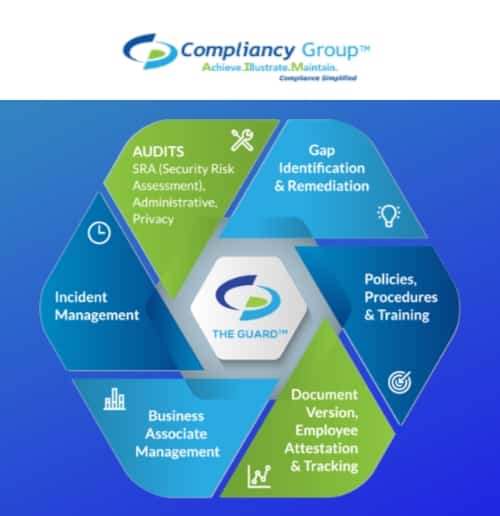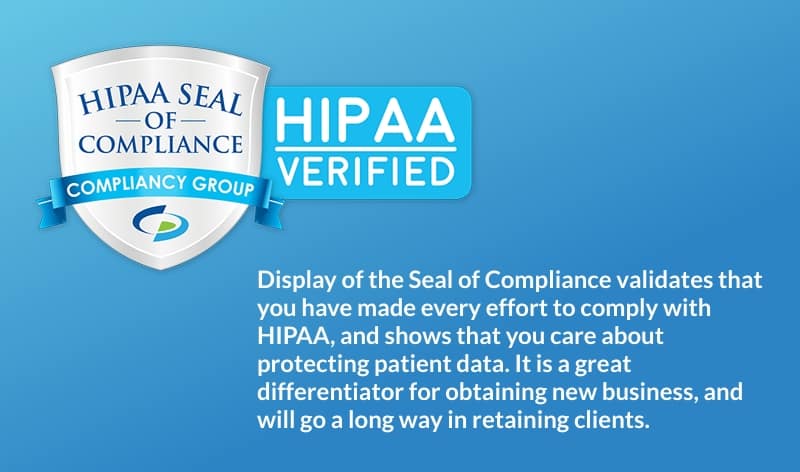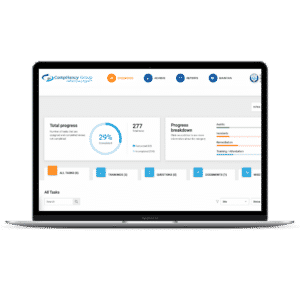What is HIPAA Compliance Software?
HIPAA compliance software enables healthcare organizations to manage their HIPAA compliance in one central location. This eases the process of achieving, illustrating, and maintaining your compliance.
Why You Should Use HIPAA Compliance Software
Managing your HIPAA compliance from a centralized location ensures that there are no gaps in your compliance efforts. What’s even better is that the work you do to become HIPAA compliant using HIPAA compliance software, proves your “good faith effort” towards HIPAA compliance through documentation. This allows organizations subject to a HIPAA audit to use the documentation stored in the HIPAA compliance software to demonstrate their compliance to the HHS’ OCR.
Compliancy Group’s HIPAA Compliance Software: Simplified Process
When you use Compliancy Group’s HIPAA software, the Guard, your compliance efforts are minimized.

Using our total HIPAA compliance solution, our Compliance Coaches™ guide clients through the steps required to implement an effective compliance program.
Our Achieve, Illustrate, Maintain™ methodology will provide you with all of the documentation necessary to prove your “good faith effort” towards compliance to the HHS. How do we know? Our clients have never failed a HIPAA audit!
Achieve HIPAA Compliance
To achieve HIPAA compliance, you must conduct self-audits, have written policies and procedures, train employees, and manage your business associates.
HIPAA Risk Assessment Software. To ensure that you are adequately securing protected health information (PHI) you are required to conduct annual risk assessments, as well as five other self-audits (business associates are not required to conduct a HITECH subtitle D audit). Compliancy Group’s HIPAA compliance software has a built-in risk assessment tool, that supports all six required self-audits. The tool allows for gaps in your compliance to be identified so that they may be addressed with remediation plans.
HIPAA Policies and Procedures. HIPAA requires business associates and covered entities to implement policies and procedures that dictate the proper uses and disclosures of PHI, how to secure PHI, and how to report a breach. Our policies and procedures allow clients to comply with the HIPAA Privacy, Security, and Breach Notification Rules.
HIPAA Training Software. Any employee that has the potential to access PHI is required to be trained annually. HIPAA training software allows organizations to easily train employees in accordance with HIPAA requirements. Our HIPAA compliance software has a HIPAA training software component. Our training module consists of a series of short animated videos that are sure to keep your employees engaged, while providing the knowledge they need to comply with HIPAA.
HIPAA Business Associate Management Software. Part of HIPAA compliance requires you to manage your business associates. However, depending on the size of your business, it can be difficult to track all of your business associates (BAs), and ensure that you have the proper documentation in place for each of them. HIPAA business associate management software eases this process by creating profiles for each of your vendors (business associates) making it easy to keep track of your documentation. To ensure your business associates’ compliance, you must send a vendor questionnaire to each of your BAs. As BAs create, store, maintain, receive, or transmit PHI on your behalf, you must also have signed business associate agreements with each BA. Our HIPAA compliance software allows you to send each of your BAs the documents required by HIPAA, and stores the completed documentation in your vendors’ profiles.
Illustrate HIPAA Compliance
Achieving HIPAA compliance ensures that you are doing everything required to secure PHI, but you must also be able to prove your compliance.
HIPAA Documentation. A key component of HIPAA compliance is the ability to prove that you have made every effort to comply with the law. This is done by keeping documented proof that you have taken all of the steps required by the HHS to maintain the confidentiality, integrity, and availability of PHI. As you complete our guided process, all of the documentation to prove your “good faith effort” is built and stored in our HIPAA compliance software.
HIPAA Verification and Validation. Although there is a common misconception that you can receive a HIPAA certification, the HHS does not recognize HIPAA certificates. This is because HIPAA compliance requires ongoing efforts to maintain your compliance. However, our HIPAA Seal of Compliance™ serves as a third-party verification and validation tool. Compliancy Group’s clients that complete our HIPAA compliance implementation process will have their compliance program verified by their Coach. Upon verification, you are eligible to receive our Seal that can be displayed on your website or email signature.

Maintain HIPAA Compliance
It is not enough to put a compliance program in place, you must maintain your compliance. As businesses evolve, their compliance needs may change, thus requiring you to update your documentation. In addition, as part of maintaining HIPAA compliance, you must also report any breach affecting PHI.
Annual Self-audits. Conducting annual self-audits allows you to measure your current compliance effort against HIPAA’s requirements. Self-audits must be conducted annually to account for any changes to your business practices.
HIPAA Breach Notification Software. Should you experience a breach, you are required to report the incident to affected patients, the HHS’ OCR, and for breaches affecting 500 or more patients, the media. HIPAA breach notification software allows employees to anonymously report breaches, or other incidents affecting PHI, to the HHS’ OCR so that they may be investigated. Compliancy Group’s HIPAA compliance software allows employees to anonymously report suspected incidents. As far as reporting the incident to affected patients, this must be done by mailing breach notification letters. Breaches affecting 500 or more patients must also be posted on the organization’s website, and reported to local news organizations.
HIPAA Audit Support Software. HIPAA audits can occur for any number of reasons such as breach investigation or patient complaints. To avoid HIPAA fines, organizations subject to a HIPAA audit must be able to prove that they complied with HIPAA standards through written documentation. Compliancy Group’s HIPAA compliance software providers clients with all of the documentation that they need to support their compliance claims.

We treat our employees like family, providing them the tools they need to be successful. We strive to keep our employees focused and happy, not only to provide the best place to work, but to be the best place to work with!
As a client, you are welcomed into our family so you know that when you work with us you are getting the best possible customer service. Let us show you why we were chosen 2020 Best Places to Work and Fastest Growing Private Companies in America by Inc. Magazine.

When Does Software Need to Be HIPAA Compliant?
Under HIPAA, software providers are considered business associates if they create, receive, store, transmit, or maintain PHI on your behalf. This is because even though they may not access the PHI you share through their platform, they have the potential to access PHI, and as such they need to be HIPAA compliant. Software providers that may fall into this category are email providers, web hosting services, marketing tools, appointment scheduling tools, etc.
What is HIPAA Compliant Software?
HIPAA compliant software includes software that has security measures in place to ensure the confidentiality, integrity, and availability of PHI. This is accomplished through measures such as:
User Authentication. To prevent unauthorized access to PHI, each employee must have unique login credentials to access software tools. The software you use must be capable of providing each user with a unique username and password to access the platform. For an added layer of protection, software that uses multi-factor authentication (MFA) should be considered. MFA uses multiple login credentials, such as a username and password in combination with security questions or a one-time PIN, to further authenticate users.
Access Controls. HIPAA requires employees to only have access to the PHI that they need access to perform their job functions (known as the minimum necessary standard). HIPAA compliant software allows administrators to designate different levels of access to PHI, based on an employee’s job role, using their unique login credentials.
Audit Controls. To ensure adherence to the minimum necessary standard, and to facilitate the quick detection of breaches, access to PHI must be tracked. Using an audit log, regular access patterns to PHI can be established for each employee.
Encryption. The best way to secure PHI is through encryption. Encryption prevents unauthorized access to PHI by transforming sensitive data into a code that can only be read with a decryption key.
Business Associate Agreements. In addition to security measures, HIPAA compliant software providers must sign business associates agreements (BAAs) before the software can be used in conjunction with PHI. A BAA dictates the security measures that your business associate is required to have in place. It also requires each signing party to be responsible for maintaining their own compliance.
Employee Training. Although security measures and BAAs are important aspects of software compliance, HIPAA compliant software is dependent on how it is used by the end users. As such, employees must be trained on the proper uses and disclosures of PHI with respect to the software being used.





